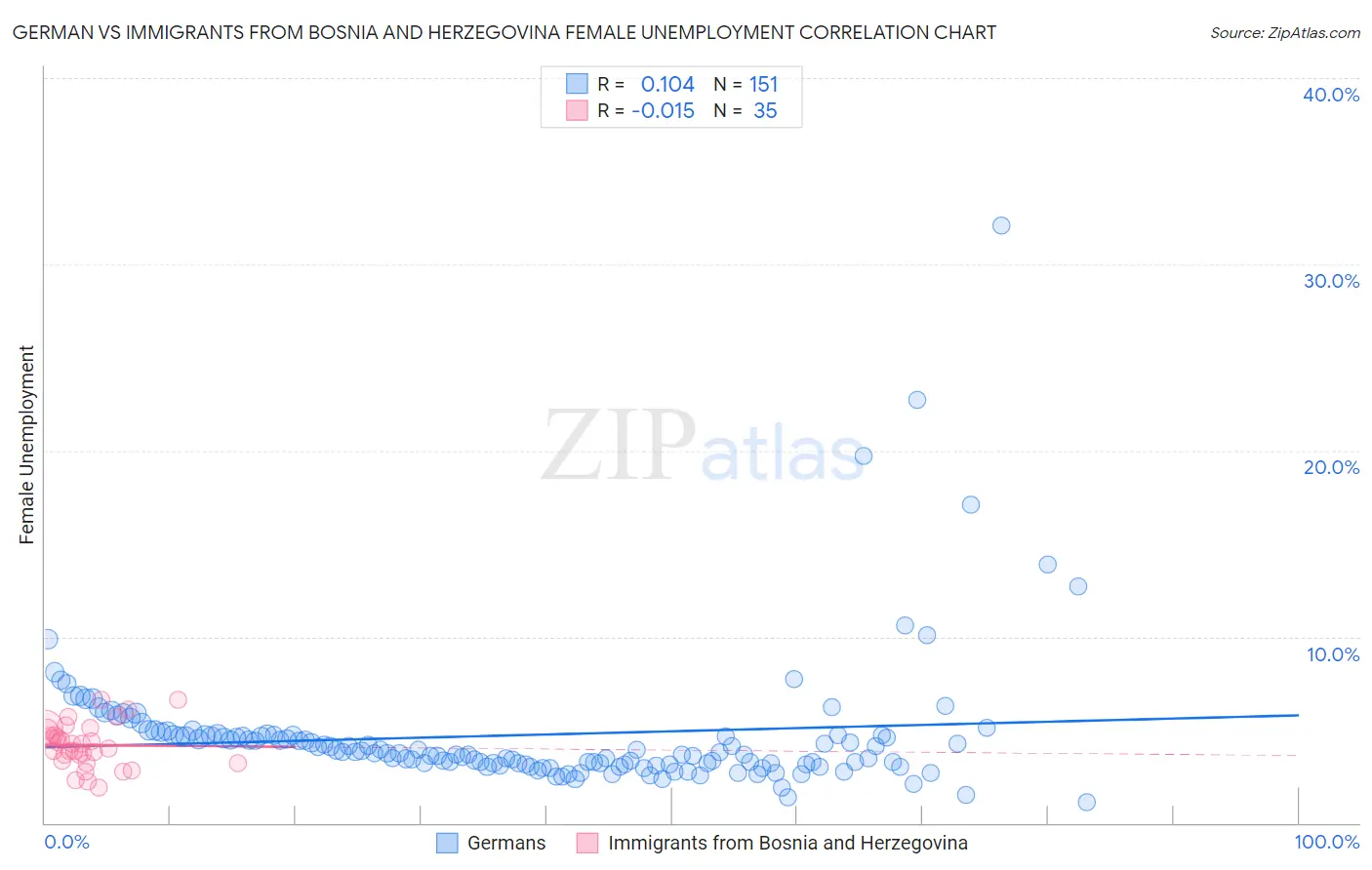German vs Immigrants from Bosnia and Herzegovina Female Unemployment
COMPARE
German
Immigrants from Bosnia and Herzegovina
Female Unemployment
Female Unemployment Comparison
Germans
Immigrants from Bosnia and Herzegovina
4.5%
FEMALE UNEMPLOYMENT
100.0/ 100
METRIC RATING
8th/ 347
METRIC RANK
4.7%
FEMALE UNEMPLOYMENT
99.9/ 100
METRIC RATING
26th/ 347
METRIC RANK
German vs Immigrants from Bosnia and Herzegovina Female Unemployment Correlation Chart
The statistical analysis conducted on geographies consisting of 564,194,310 people shows a poor positive correlation between the proportion of Germans and unemploymnet rate among females in the United States with a correlation coefficient (R) of 0.104 and weighted average of 4.5%. Similarly, the statistical analysis conducted on geographies consisting of 156,582,357 people shows no correlation between the proportion of Immigrants from Bosnia and Herzegovina and unemploymnet rate among females in the United States with a correlation coefficient (R) of -0.015 and weighted average of 4.7%, a difference of 5.5%.

Female Unemployment Correlation Summary
| Measurement | German | Immigrants from Bosnia and Herzegovina |
| Minimum | 1.1% | 1.9% |
| Maximum | 32.1% | 6.6% |
| Range | 31.0% | 4.7% |
| Mean | 4.7% | 4.2% |
| Median | 3.8% | 4.3% |
| Interquartile 25% (IQ1) | 3.2% | 3.4% |
| Interquartile 75% (IQ3) | 4.7% | 5.0% |
| Interquartile Range (IQR) | 1.5% | 1.7% |
| Standard Deviation (Sample) | 3.7% | 1.2% |
| Standard Deviation (Population) | 3.6% | 1.2% |
Demographics Similar to Germans and Immigrants from Bosnia and Herzegovina by Female Unemployment
In terms of female unemployment, the demographic groups most similar to Germans are Chinese (4.5%, a difference of 0.020%), Slovene (4.5%, a difference of 0.36%), Swiss (4.6%, a difference of 1.7%), Scandinavian (4.6%, a difference of 1.8%), and Dutch (4.6%, a difference of 2.4%). Similarly, the demographic groups most similar to Immigrants from Bosnia and Herzegovina are Immigrants from India (4.7%, a difference of 0.040%), Welsh (4.7%, a difference of 0.13%), British (4.7%, a difference of 0.17%), Scottish (4.7%, a difference of 0.33%), and European (4.7%, a difference of 0.89%).
| Demographics | Rating | Rank | Female Unemployment |
| Chinese | 100.0 /100 | #7 | Exceptional 4.5% |
| Germans | 100.0 /100 | #8 | Exceptional 4.5% |
| Slovenes | 100.0 /100 | #9 | Exceptional 4.5% |
| Swiss | 100.0 /100 | #10 | Exceptional 4.6% |
| Scandinavians | 100.0 /100 | #11 | Exceptional 4.6% |
| Dutch | 100.0 /100 | #12 | Exceptional 4.6% |
| Belgians | 100.0 /100 | #13 | Exceptional 4.6% |
| Finns | 100.0 /100 | #14 | Exceptional 4.6% |
| English | 100.0 /100 | #15 | Exceptional 4.6% |
| Carpatho Rusyns | 99.9 /100 | #16 | Exceptional 4.7% |
| Croatians | 99.9 /100 | #17 | Exceptional 4.7% |
| Latvians | 99.9 /100 | #18 | Exceptional 4.7% |
| Poles | 99.9 /100 | #19 | Exceptional 4.7% |
| Bulgarians | 99.9 /100 | #20 | Exceptional 4.7% |
| Fijians | 99.9 /100 | #21 | Exceptional 4.7% |
| Europeans | 99.9 /100 | #22 | Exceptional 4.7% |
| Scottish | 99.9 /100 | #23 | Exceptional 4.7% |
| Welsh | 99.9 /100 | #24 | Exceptional 4.7% |
| Immigrants | India | 99.9 /100 | #25 | Exceptional 4.7% |
| Immigrants | Bosnia and Herzegovina | 99.9 /100 | #26 | Exceptional 4.7% |
| British | 99.9 /100 | #27 | Exceptional 4.7% |